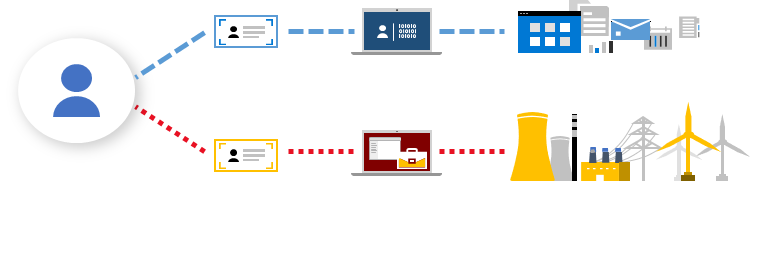Over the last fifteen years, attacks against critical infrastructure (figure1) have steadily increased in both volume and sophistication. Because of the strategic importance of this industry to national security and economic stability, these organizations are targeted by sophisticated, patient, and well-funded adversaries. Adversaries often target the utility supply chain to insert malware into devices destined for the power grid. As modern infrastructure becomes more reliant on connected devices, the power industry must continue to come together to improve security at every step of the process.

Figure 1: Increased attacks on critical infrastructure
This is the third and final post in the “Defending the power grid against supply chain attacks” series. In the first blog I described the nature of the risk. Last month I outlined how utility suppliers can better secure the devices they manufacture. Today’s advice is directed at the utilities. There are actions you can take as individual companies and as an industry to reduce risk.
Implement operational technology security best practices
According to Verizon’s 2019 Data Breach Investigations Report, 80 percent of hacking-related breaches are the result of weak or compromised passwords. If you haven’t implemented multi-factor authentication (MFA) for all your user accounts, make it a priority. MFA can significantly reduce the likelihood that a user with a stolen password can access your company assets. I also recommend you take these additional steps to protect administrator accounts:
- Separate administrative accounts from the accounts that IT professionals use to conduct routine business. While administrators are answering emails or conducting other productivity tasks, they may be targeted by a phishing campaign. You don’t want them signed into a privileged account when this happens.
- Apply just-in-time privileges to your administrator accounts. Just-in-time privileges require that administrators only sign into a privileged account when they need to perform a specific administrative task. These sign-ins go through an approval process and have a time limit. This will reduce the possibility that someone is unnecessarily signed into an administrative account.

Figure 2: A “blue” path depicts how a standard user account is used for non-privileged access to resources like email and web browsing and day-to-day work. A “red” path shows how privileged access occurs on a hardened device to reduce the risk of phishing and other web and email attacks.
- You also don’t want the occasional security mistake like clicking on a link when administrators are tired or distracted to compromise the workstation that has direct access to these critical systems. Set up privileged access workstations for administrative work. A privileged access workstation provides a dedicated operating system with the strongest security controls for sensitive tasks. This protects these activities and accounts from the internet. To encourage administrators to follow security practices, make sure they have easy access to a standard workstation for other more routine tasks.
The following security best practices will also reduce your risk:
- Allow list approved applications. Define the list of software applications and executables that are approved to be on your networks. Block everything else. Your organization should especially target systems that are internet facing as well as Human-Machine Interface (HMI) systems that play the critical role of managing generation, transmission, or distribution of electricity
- Regularly patch software and operating systems. Implement a monthly practice to apply security patches to software on all your systems. This includes applications and Operating Systems on servers, desktop computers, mobile devices, network devices (routers, switches, firewalls, etc.), as well as Internet of Thing (IoT) and Industrial Internet of Thing (IIoT) devices. Attackers frequently target known security vulnerabilities.
- Protect legacy systems. Segment legacy systems that can no longer be patched by using firewalls to filter out unnecessary traffic. Limit access to only those who need it by using Just In Time and Just Enough Access principles and requiring MFA. Once you set up these subnets, firewalls, and firewall rules to protect the isolated systems, you must continually audit and test these controls for inadvertent changes, and validate with penetration testing and red teaming to identify rogue bridging endpoint and design/implementation weaknesses.
- Segment your networks. If you are attacked, it’s important to limit the damage. By segmenting your network, you make it harder for an attacker to compromise more than one critical site. Maintain your corporate network on its own network with limited to no connection to critical sites like generation and transmission networks. Run each generating site on its own network with no connection to other generating sites. This will ensure that should a generating site become compromised, attackers can’t easily traverse to other sites and have a greater impact.
- Turn off all unnecessary services. Confirm that none of your software has automatically enabled a service you don’t need. You may also discover that there are services running that you no longer use. If the business doesn’t need a service, turn it off.
- Deploy threat protection solutions. Services like Microsoft Threat Protection help you automatically detect, respond to, and correlate incidents across domains.
- Implement an incident response plan: When an attack happens, you need to respond quickly to reduce the damage and get your organization back up and running. Refer to Microsoft’s Incident Response Reference Guide for more details.
Speak with one voice
Power grids are interconnected systems of generating plants, wires, transformers, and substations. Regional electrical companies work together to efficiently balance the supply and demand for electricity across the nation. These same organizations have also come together to protect the grid from attack. As an industry, working through organizations like the Edison Electric Institute (EEI), utilities can define security standards and hold manufacturers accountable to those requirements.
It may also be useful to work with The Federal Energy Regulatory Committee (FERC), The North American Electric Reliability Corporation (NERC), or The United States Nuclear Regulatory Commission (U.S. NRC) to better regulate the security requirements of products manufactured for the electrical grid.
Apply extra scrutiny to IoT devices
As you purchase and deploy IoT devices, prioritize security. Be careful about purchasing products from countries that are motivated to infiltrate critical infrastructure. Conduct penetration tests against all new IoT and IIoT devices before you connect them to the network. When you place sensors on the grid, you’ll need to protect them from both cyberattacks and physical attacks. Make them hard to reach and tamper-proof.
Collaborate on solutions
Reducing the risk of a destabilizing power grid attack will require everyone in the utility industry to play a role. By working with manufacturers, trade organizations, and governments, electricity organizations can lead the effort to improve security across the industry. For utilities in the United States, several public-private programs are in place to enhance the utility industry capabilities to defend its infrastructure and respond to threats:
Read Part 1 in the series: “Defending the power grid against cyberattacks”
Read “Defending the power grid against supply chain attacks: Part 2 – Securing hardware and software”
Read how Microsoft Threat Protection can help you better secure your endpoints.
Learn how MSRC developed an incident response plan
Bookmark the Security blog to keep up with our expert coverage on security matters. For more information about our security solutions visit our website. Also, follow us at @MSFTSecurity for the latest news and updates on cybersecurity.







